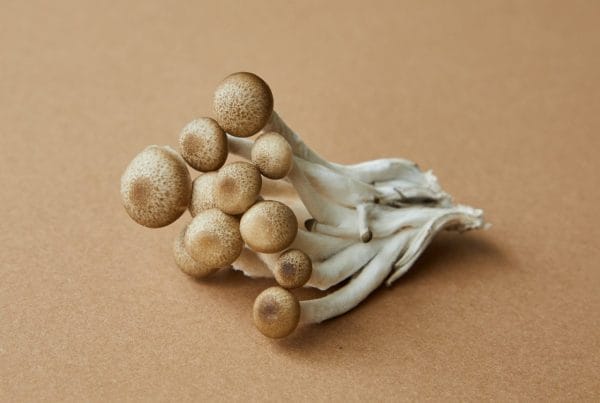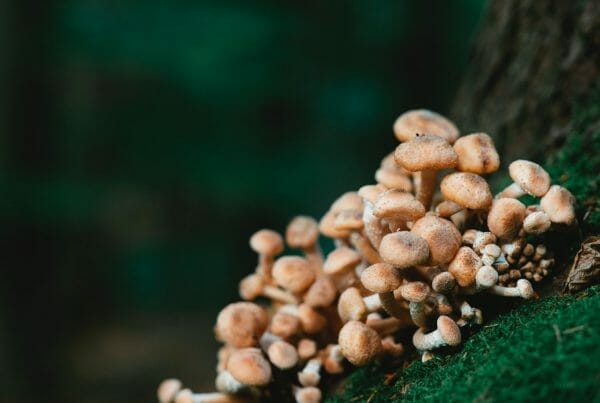Maybe Less Than You Think
Magic, psilocybin, psychedelic, or shrooms, are all common terms describing the psychoactive qualities of mushrooms containing both psilocybin and psilocin. Both of these substances occur naturally, and they both have the same effect on the body and mind. The main difference between the two is a matter of stability and under what conditions they are available. Magic mushrooms maintain a stable amount of psilocybin, and the level of that psilocybin is much higher than psilocin, and that psilocybin content remains stable in a dried mushroom for long periods. Outside of the body, psilocin quickly degrades when exposed to heat or oxygen, showing up as a sort of a blue bruise on the chitin (the fibrous or fleshy tissue that makes up the mushroom) when it is disturbed or picked.
Psilocin is very unstable until we humans ingest it. Once ingested, availability changes. Psilocin is largely the source of the high that mushrooms produce. The reason for this is that mushrooms are typically taken through oral ingestion. In the digestive tract, Psilocybin is broken down into psilocin by the enzyme alkaline phosphate. The psychoactive properties of Psilocybin are the same as psilocin, so when psilocybin is used in other products and the process involved is other than the inclusion of digestive enzymes, the effect is the same.
Psychoactive Chemistry
More specifically, psilocin is an “agonist” (a substance that initiates a psychoactive response when combined with a receptor), the serotonin receptor in the brain, in this case. Psilocybin needs to be passed by the liver to remove the phosphorous chain to become psilocin.
Both psilocybin and psilocin are very similar forms of tryptamine alkaloids and are analogs, structurally, of serotonin. The difference is in the chemical structure. Psilocybin contains phosphate in its chemical structure, psilocin contains hydroxyl. This phosphate in psilocybin’s structure makes it more stable, whereas psilocin oxidizes, and bruises blue, a sign that you’ve found yourself a magic mushroom!
When the psilocybin binds to the 2A receptor (specifically the 5-HT2A receptor) it initiates the release of the neurotransmitter in “neuronal avalanches.” These are synchronized, organized and produce effects similar to what the body experiences during REM sleep.
Potency
A magic mushroom psilocin trip lasts between 5 to 8 hours, and the experience is quite visual (colours are brighter, halos appear) and psychologically provides a general sense of well-being.
Psilocin is the pharmacologically active agent in the body after ingestion of psilocybin, which is rapidly dephosphorylated in the body to psilocin. The potency discussion is more about stability and availability than which is more potent. Some species of magic mushrooms are more potent than other species, that is because they contain a higher concentration of psilocybin and psilocin. Different batches of the same species can have different potencies as well. The most common magic mushroom is Psilocybe cubensis. Dried Psilocybe cubensis can contain roughly 0.5 to 1.0% total psilocin, averaging around 0.7% by weight; 0.7% total psilocin equates to about 1% psilocybin, check out shrooms chocolate bar.
So, what effects do different doses of psilocybin have? A low dose of dried mushrooms is about 1gram, which is about 10mg of psilocybin. A medium dose of dried mushrooms is about 1.74 grams, which is about 17.5 mg of psilocybin. A high dose of dried mushrooms is about 3.5 grams, which is about 35 mg of psilocybin. An ultra-high dose of dried mushrooms is 5 grams, which is about 50 mg of psilocybin.
What Does All of This Mean?
Both excitatory and inhibitory receptors react with psilocin augmenting or inhibiting neurotransmission. This occurs in the hippocampus and anterior cingulate cortex, an area linked to emotional thinking and memory. Psilocybin increases function and synergy in the prefrontal cortex, linked with high-level thinking and complex behaviours, making these areas uncoordinated and disjointed.
So… psilocin is more linked to emotional thinking and memory, whereas psilocybin is linked more with increasing function and synergistic activity.
Clearly, these substances have an immediate effect, but they also are showing long-term neurological and physiological benefits.






